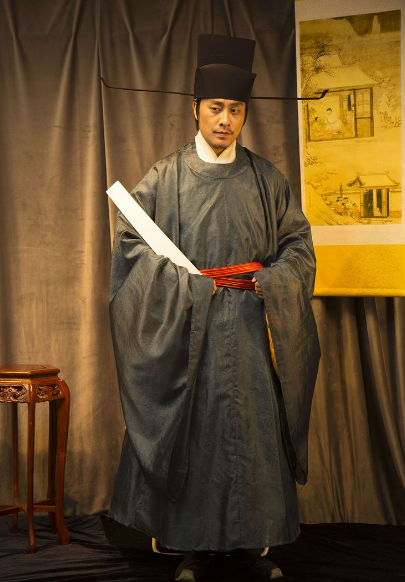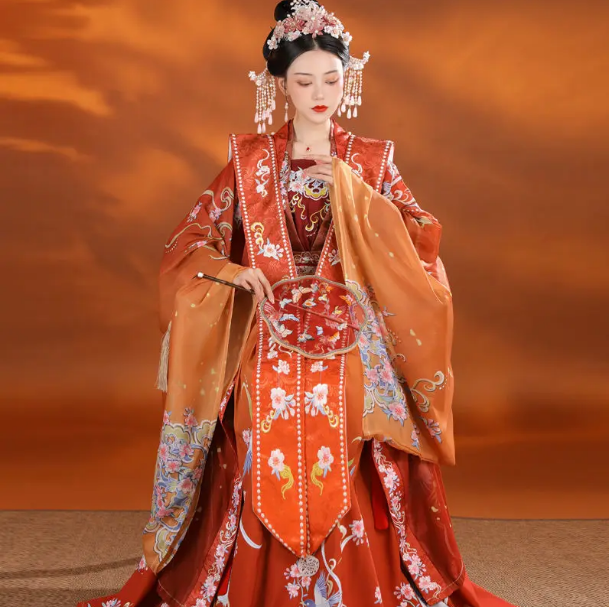Historical Context of Song Dynasty Attire
The Song Dynasty, spanning from 960 to 1279 AD, marks a pivotal era in Chinese history, particularly in fashion evolution. This period saw remarkable advancements in textile production and clothing design, significantly influenced by the dynasty’s flourishing economy and cultural prosperity.
Emergence of Distinctive Styles
During this era, court attire began to exhibit unique characteristics that distinguished it from previous dynasties. Garments became more elaborate, with an emphasis on intricate details and sophisticated aesthetics. Silk, highly prized for its luster and texture, became the predominant material in court clothing. The introduction of new weaving and dyeing techniques allowed for a wider range of colors and patterns, which were often symbolic and indicative of the wearer’s status and role in the royal court.

Influence of Social and Political Factors
Social and political dynamics of the Song Dynasty had a profound impact on court attire. The Confucian ideals, emphasizing modesty and restraint, influenced clothing designs to be more subdued yet elegant. The government’s strict hierarchy system was reflected in the clothing, where colors, patterns, and the number of ornaments worn were meticulously regulated based on the wearer’s rank and position. This dress code not only reinforced social order but also served as a visual representation of the sophisticated bureaucratic system of the Song Dynasty.
Each piece of attire in the Song court, from the emperor’s dragon robe to the official’s surcoat, was a testament to the era’s rich cultural heritage and social structure. The refinement and elegance of Song Dynasty court costumes continue to be celebrated in modern times, often serving as inspiration in fashion and art.
For more detailed information on specific aspects of Song Dynasty attire, you can explore the Song Dynasty page on Wikipedia, which provides a comprehensive overview of the historical and cultural context of this period.
Materials and Fabrics Used in Court Costumes
The Song Dynasty showcases an era where court costumes not only reflect status but also demonstrate the era’s finest materials and craftsmanship. The selection of fabrics and their quality played a crucial role in the aesthetics and symbolism of royal attire.
Common Textiles in Royal Garments
Silk, renowned for its luxurious texture and sheen, stands as the most prominent material in royal garments. Artisans in the Song Dynasty mastered silk production, offering a variety of weaves like damask, brocade, and gauze. These textiles, celebrated for their beauty, also boasted durability and comfort. Cotton, though less prestigious than silk, found use in the attire of lower-ranking officials and for practical, everyday garments.
Symbolism and Quality of Fabrics
The quality of fabrics in court costumes was unparalleled, often incorporating gold and silver threads for added opulence. Colors carried symbolic weight; for example, yellow, reserved for the emperor, signified supreme authority. Embroideries on these fabrics, depicting dragons, phoenixes, and other mythical creatures, symbolized different virtues and powers. The careful selection of these motifs was not just an aesthetic choice but also a reflection of the wearer’s rank and virtues.
These materials were more than just garments; they embodied the artistry and cultural values of the Song Dynasty. Their legacy extends beyond their time, influencing modern fashion and textile arts.
For more insights into the materials and their cultural significance, you can delve into the detailed history and evolution of Silk and Textile arts of China on Wikipedia.
Design and Aesthetics of Royal Attire
The Song Dynasty’s royal attire showcases an exquisite blend of aesthetics and tradition, where every detail reflects careful thought and cultural significance. The design of these garments not only adheres to aesthetic principles but also embodies the era’s values and ideologies.
Color Schemes and Their Significance
In royal attire, color schemes were not merely a matter of preference but carried deep symbolic meanings. The emperor often donned yellow or gold, symbolizing the sun and his divine authority. Blue and green were popular among the nobility, representing harmony and growth. Red, associated with joy and fortune, was commonly used in garments for festive occasions. The choice of these colors was a deliberate act, aligning with Confucian ideals of order and harmony.
Patterns and Embroideries
Patterns and embroideries in royal costumes were intricate and meaningful. Dragons, a symbol of imperial power and authority, frequently adorned the emperor’s robes. Phoenixes, representing grace and virtue, were often seen in the queen’s attire. Other motifs like clouds, waves, and mountains, each with its own symbolic meaning, added layers of significance to the garments. Artisans employed meticulous techniques to bring these designs to life, ensuring each stitch reflected precision and elegance.
The design and aesthetics of Song Dynasty royal attire are not just historical artifacts; they continue to inspire modern fashion and art, symbolizing a rich cultural heritage. For further exploration of the artistic and cultural context of these designs, delve into Chinese Art and Song Dynasty culture on Wikipedia.
Hierarchy and Court Dress Codes
The Song Dynasty’s court dress codes were a complex system reflecting the rigid hierarchical structure of the time. These codes not only represented one’s social status but also enforced the dynasty’s values of order and propriety.
Dressing According to Rank and Status
Every rank in the court had a specific dress code, meticulously defined by the government. The emperor, at the pinnacle, wore robes with dragon motifs, symbolizing supreme power. High-ranking officials donned robes with specific patterns and colors, indicating their position and rank. Lower-ranking officials and servants had simpler attire, with fewer decorations and more subdued colors. This clear distinction in attire ensured immediate recognition of one’s status and rank within the court.
Rules and Regulations for Court Attire
The Song Dynasty imposed strict rules on court attire, with regulations specifying not only the style and color of garments but also the types of jewels and accessories permissible for each rank. These regulations, updated and recorded in official documents, were integral to maintaining the social order. Any deviation from these prescribed codes was seen as a challenge to the established hierarchy and could result in severe penalties.
The court dress codes of the Song Dynasty offer a fascinating glimpse into the era’s social structure and values. They exemplify how clothing served as a powerful tool to reinforce societal norms and order. For a deeper understanding of these historical nuances, explore Song Dynasty and Chinese clothing on Wikipedia.

Gender Differences in Court Costumes
The Song Dynasty’s court costumes vividly illustrate gender differences, with distinct styles and ornamentation for men and women. These differences not only reflect fashion preferences but also societal roles and expectations of the era.
Distinctive Features of Male and Female Attire
Male attire in the court primarily focused on showcasing authority and rank. Emperors and high-ranking officials wore robes with dragon motifs and intricate embroideries, often in bold colors. For women, elegance and grace were the key elements. The queen and noblewomen wore flowing robes with delicate patterns, often featuring phoenix and floral motifs. The colors for women’s attire were usually softer, with an emphasis on harmonious and subtle designs.
Evolution of Women’s Court Dress
Women’s court dress in the Song Dynasty underwent significant changes, reflecting shifts in societal norms and aesthetics. Initially, women’s attire closely resembled male garments but gradually evolved to become more distinct. The introduction of the Beizi (a long, loose overcoat) and the Shenyi (a one-piece robe) marked significant developments in women’s fashion. These garments not only offered more comfort and freedom of movement but also allowed for more elaborate designs and ornamentation.
The gender differences in court costumes during the Song Dynasty not only showcase the era’s fashion but also provide insights into the gender roles and societal expectations of the time. For further exploration of this topic, delve into Song Dynasty clothing and Chinese clothing on Wikipedia.
Ceremonial and Everyday Court Attire
In the Song Dynasty, court attire was not a uniform style but varied significantly based on the occasion, be it a grand ceremony or daily life. This distinction in clothing highlighted the dynasty’s attention to both formality and practicality.
Costumes for Special Occasions and Ceremonies
Special occasions and ceremonies called for the most extravagant attire. Emperors, empresses, and high-ranking officials wore opulent dragon robes adorned with gold and silver threads. These garments featured intricate designs and vivid colors, symbolizing power and authority. For women, ceremonial attire included elaborate phoenix robes and ornate hair accessories, adding to the grandeur of the event.
Daily Wear for Royalty and Nobility
While ceremonies demanded splendor, daily wear for royalty and nobility was marked by a balance of elegance and comfort. Men typically wore layered robes, with the Beizi and Shenyi being popular choices. Women favored attire that allowed ease of movement, such as Ruqun or Aoqun. These garments were still beautifully crafted but less ornate than ceremonial attire. Colors remained harmonious, and patterns were simpler, reflecting the practicality needed for daily activities.
The distinction between ceremonial and everyday court attire in the Song Dynasty exemplifies the era’s cultural values and societal norms. These clothing choices not only showcased the dynasty’s grandeur during special events but also emphasized the practicality and functionality required for daily life. To delve deeper into this topic, explore Song Dynasty clothing and Chinese clothing on Wikipedia.







